The biggest untold issue with "customer obsession"

Customer Support Manager - Tier 1

Tags
Share
Many companies say that they’re “obsessed with their customers” as a kind of short-hand way of saying how great their customer experience is.
That relies on the assumption, of course, that customer obsession is what drives an awesome customer experience.
But that’s an assumption that I’d like to challenge.
What if there were a way to provide an amazing customer experience—without resorting to full-on customer obsession?
What if I told you that trying to be a “customer-obsessed company” might actually come at the expense of your customer support teams’ wellbeing? If happy agents provide better customer service, what are the implications?
I’ll talk about these ideas in more detail in just a bit—and an alternative way to exceed customer expectations and provide a good experience, without sacrificing your agents’ health and happiness.
What is “customer obsession?”
Customer obsession is a business ethos that focuses on prioritizing customer needs above all else (hence “obsession”). From the onboarding process to the social media strategy and retention phrases, customer obsession starts with looking at every single possible touchpoint your customers have with you—and making those interactions as easy and enjoyable for them as possible.
E-commerce companies like Zappos and Amazon are notorious for this. Every step of the checkout flow is efficient, and their return policies are famous for how convenient they are. In fact, you can even make the argument that they’ve built their brands on being customer-obsessed. But many companies like Amazon are also known for working conditions that aren’t always the greatest, and a higher level of stress on customer-facing teams.
It’s clear that aspiring to reach a certain level of customer obsession comes at a cost. Someone has to be the person or agent who’s scrambling through pages of policies and putting up with irate and even abusive customers to give you that “great customer experience.”
So, what if there were another way to earn loyal customers?
Another way to look at being customer-obsessed
Whether you’re an entrepreneur of a startup or running a 200-person company, here are a few concepts to rethink if you want to provide a good customer experience while still maintaining a healthy company culture.
Empowered agents vs. metrics, metrics, metrics
Yes, metrics are important. I’m not saying that we can just forget about them. But I’d argue that what’s equally important is making sure your agents are actually empowered to hit those metrics.
For example, at Dialpad, our support team has a wide variety of metrics, like service levels, that we have to hit. But we don’t just give our agents a phone system or a login to our contact center software and say, “Okay, make sure your response times are X.”
We give them the tools to help them do that. Like the Real-Time Assist (RTA) cards that pop up with helpful notes on their screens. If we know that customers are asking about tricky topics, like how our number porting process works, we can create an RTA card with notes on that subject, and set it to trigger automatically on agents’ screens whenever “port” or “porting” is spoken on a call:

This way, even new agents are empowered to answer customer questions and hit resolution targets—without having to go to a teammate or manager for help—and our supervisors don’t have to personally coach every call.
👉 Related:
Learn more about metrics like NPS, CSAT, customer retention, and more.
Use automations where you can
You can’t compromise on providing high-quality service—but your resources and time are finite. Every customer support team, including ours, faces this challenge.
This is where automations can really help a customer-obsessed company. One simple example that most of us are familiar with is the IVR (Interactive Voice Response) menu. When someone calls a bank, for example, they usually hear a recorded menu with options for if they want to check their account balance, apply for a credit card, talk to an agent, and more.
That’s a really easy automation to set up, and it helps you give customers the answers or help they need—while taking redundant tasks off your agents’ plates.
One of the neat things about working in support at Dialpad is that we can use our own contact center platform. And it’s really easy to set up an IVR or make changes to our call routing—it takes just a few clicks, and the changes are made in real time:
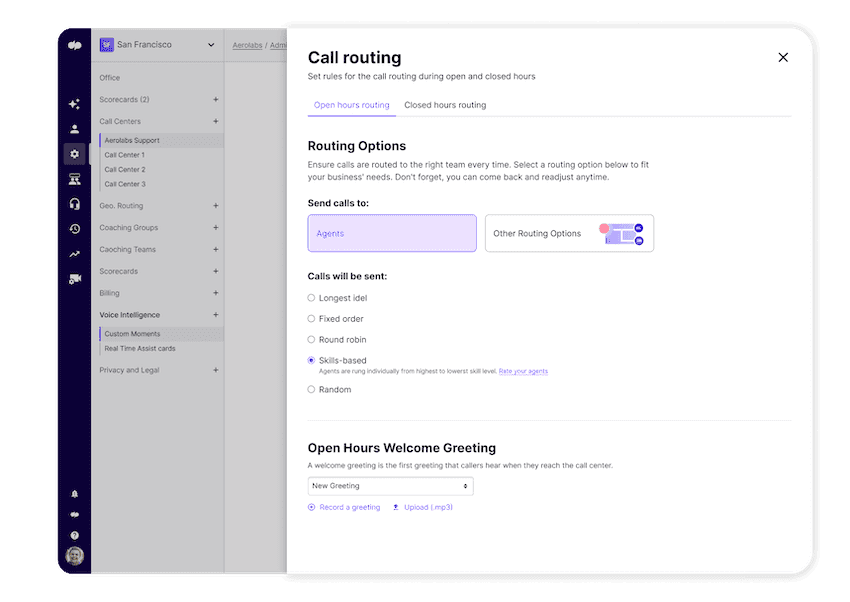
Another important automation to have as a customer-facing team is to make sure your existing customer relationship management (CRM) platform and business phone system or contact center platformare integrated.
Your CRM holds everything your team needs to know about your customer base, from contact details to past relationship history. For us, this is a useful automation because it means that when a customer calls us for help, any of our agents can quickly see all that customer data that’s pulled from our CRM and know that person’s history with us—even if they’ve never spoken to that customer before.
Our software, Dialpad Ai Contact Center, actually integrates with a wide variety of CRMs like Salesforce, HubSpot, and Zoho CRM. Here’s how the Salesforce integration looks, for example:

The bonus: They don’t have to be obsessed with our customers to do it. Work smarter, not harder, right?
Alignment across every department
At many companies, the whole being “customer-centric” thing tends to fall on one or two teams: the customer support team, and sometimes the customer success team.
But this isn’t the best way—and it actually makes those agents’ jobs harder. Every team in your company should be dedicated to customer success, and supporting those departments along all the important touchpoints along the buyer’s journey is key. If you’re an exec or in the C Suite, make sure that discussions about customer service are entering the boardroom. Integrating CX into your leadership principles and priorities will help make sure that your customer experience is being driven from the top down.
Even your Legal and Finance teams can directly impact the customer experience. They’re the ones approving contracts and purchase agreements. Imagine if they operated with the customer in mind, instead of just doing their own thing and leaving your customer support team to deal with the customer relationship.
This way, your agents don’t have to bear the burden of customer obsession all on their own—every team can play a small part in creating a great overall experience, and no single team has to be super obsessed all on their own.
To do this though, everyone needs to communicate. And because the pandemic has driven many teams to adopt a remote or hybrid work approach, staying in touch with teammates looks very different today. With Dialpad, our team can take phone calls, have video meetings, send instant / SMS+MMS messages, and manage our contact center, all from a single app:
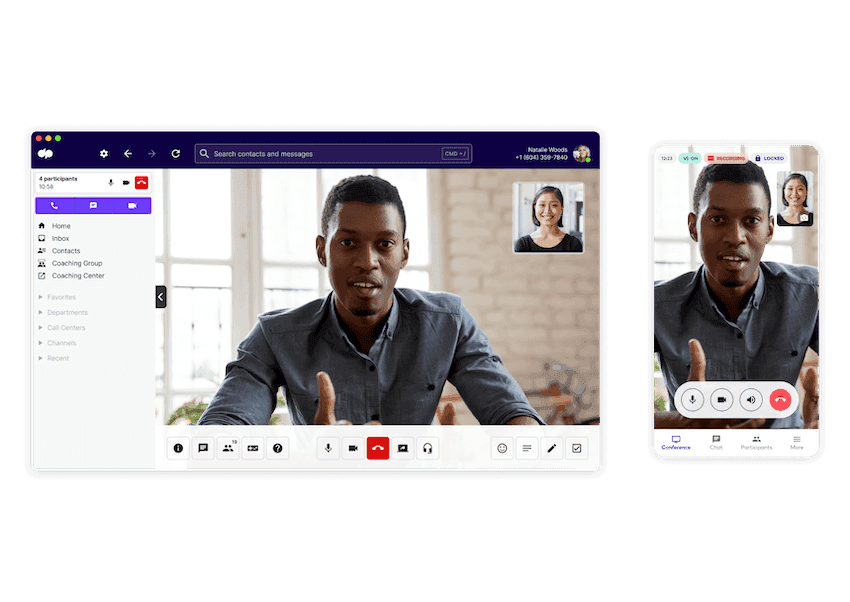
They can work from anywhere, on any device. If you don’t already have one, look into a unified communications solution with an integrated contact center platform—it can really help with cross-team collaboration (and also reduce the size of your tech stack).
Customer retention over acquisition
Every business needs to acquire new customers. But a customer experience team’s energy can be used a lot more efficiently if you proactively retain customers too.
There’s no shortage of statistics out there talking about how customer retention is cheaper than acquisition. Don’t just focus on winning new customers—make sure you have team members dedicated to keeping the customer relationships you already have.
Building a customer-centric culture without the pitfalls of obsession
It’s time to start building a customer-centric culture that’s healthy, balanced, and doesn’t border on the fanatical. We don’t have to hurt ourselves to help our customers.
So, how can we start building customer-centric cultures the right way?
Equip your CX team with the right tools
The first thing you need to do is to equip your customer experience team with the right tools. If you have a decent-size team of agents that receive more than a few calls per day from customers or prospects, then you’ll probably need a contact center platform.
Ideally, it’ll be easy to set up and use, even if you have a distributed team. Dialpad Ai Contact Center, for example, lets us add (and remove) users, and manage phone numbers for everyone right from the online dashboard:
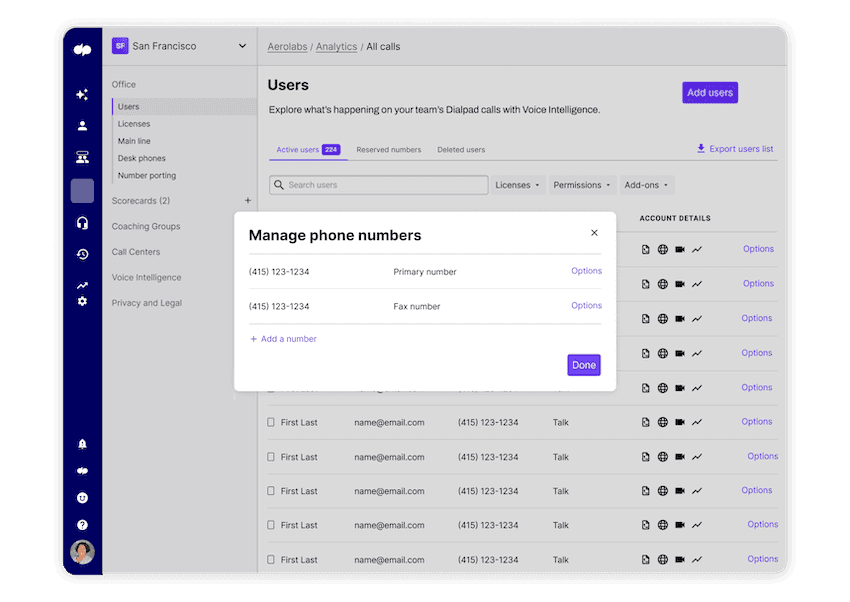
That doesn’t technically have anything to do with customer obsession, but having easy-to-use software can help free up your time so that you can focus on helping customers instead of spending hours on the phone with IT or Support. (Think of it as a secondary benefit.)
I touched on this earlier, but artificial intelligence (AI) is what can really supercharge your agents and help them provide fantastic service without burning out. So, what can AI actually do?
Well for one, AI features can eliminate repetitive tasks. Dialpad Ai, for instance, can transcribe calls in real time...

... Track how often keywords come up in customer calls (like a competitor’s name or that exciting new product you just released), and even analyze sentiment of calls in real time:
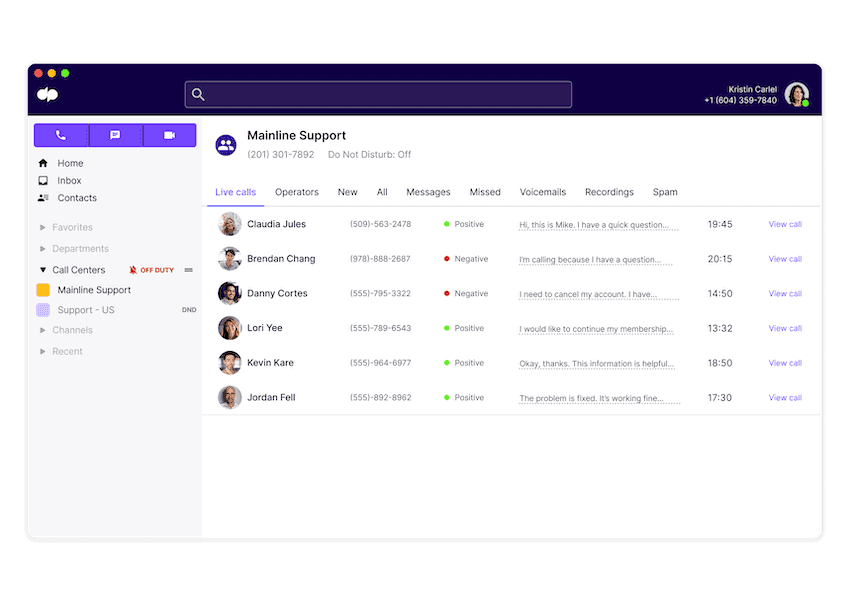
All of these help make our supervisors more efficient, provide training to agents at scale, and get more insights into customer satisfaction—with way less manual work.
Collect customer feedback regularly
If you really care about your customers, you should care about their feedback.
But again, you don’t necessarily need to expend a ton of energy to collect, organize, and use this customer feedback. It doesn’t need to be a laborious process.
In fact, with the right tools, you can automate a lot of this process.
We can create customer satisfaction survey in Dialpad with just a few clicks to collect feedback from customers right after a call. And if they give any additional feedback, Dialpad Ai can transcribe it so our team can refer back to it later:

No need to obsess about remembering to ask customers for feedback manually.
Dialpad Ai also goes one step further. One of the biggest challenges by far with these CSAT surveys is that not a lot of people actually bother to fill them out.
In fact (depending on the industry and specific business of course), we've found that on average only about 5% of customers actually fill out CSAT surveys. On a related note, usually only the angriest—and happiest—customers actually respond to these surveys, which means your CSAT answers are likely to be very skewed and not representative of how your customers feel overall.
Dialpad's industry-first Ai CSAT feature is designed to solve exactly that. Not only can our Ai transcribe calls and analyze sentiment in real time, it can also infer CSAT scores for 100% of your customer calls thanks to its hyper-accurate transcription feature. The result? A much more representative sample size for CSAT scores, and a more accurate understanding of how satisfied your customers really are:
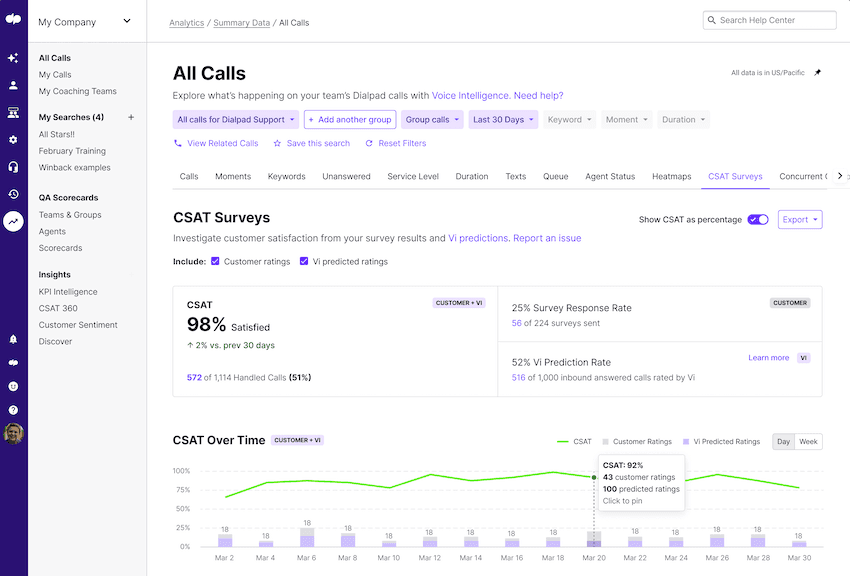
We’re still getting that customer intelligence, but it’s done for us by Dialpad without creating a larger burden for our agents and supervisors.
The bottom line: Customer data and insights are important. There’s no arguing that. But by rethinking what “customer obsession” entails and the kind of effort it takes, we can often still achieve similar results—without burning out our teams.
Look at how you can make micro-processes more customer-centric
I touched on this earlier, but it can be very helpful to take a closer look at your buyer journey and how each touchpoint can be more customer-centric.
Instead of a grand, sweeping plan to “boost your customer experience” (what does that even mean??), look at things from the opposite angle—get granular and see if there are small, bite-sized improvements you can make that’ll help your agents do their jobs more effectively or efficiently.
Is there an extra step in your onboarding process that isn’t necessary and could be removed to reduce friction for your customer? If your customers are often calling in to schedule an appointment and your hold times are creeping up, could you give them the option of booking from your website instead? And so on...
For me, one of the issues I have with the traditional idea of “customer obsession” is that it can seem overwhelming because to be “obsessed” with something, it implies you’re dedicating every waking moment of your life thinking about it and letting it consume, well, everything.
That’s not necessarily healthy to run a sustainable contact center (or even business), and I think by approaching micro-processes differently, we can still provide that excellent customer experience that is the hallmark of “customer-obsessed companies”—while still valuing your employees’ well-being.
Improve your customer relationships—without being obsessed
Obsession isn’t sustainable. You don’t have to work your agents to the bone with customer obsession in order to provide world-class customer service.
It’s time to rethink how we approach our customer focus, and empower our agents and teams with the tools they need, automate repetitive, low-value tasks where it makes sense to, and actually use the technology we have available to take the burden off our human agents.
If you’re looking for a contact center solution that can help you provide customer-obsessed service without the burnout, why not take a product tour of Dialpad Ai Contact Center and see how CX teams like ours are using it to provide a great experience?
Customer (and agent) happiness without the obsession
Want to provide a customer-obsessed experience more efficiently? See how Dialpad Ai Contact Center can help!








